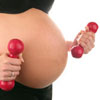- Introduction to exercise before pregnancy
- Pre-pregnancy exercise and psychology
- Gestational weight gain
- Maternal foetal disease
- Fertility
Introduction to exercise before pregnancy
Exercise during pregnancy is usually safe and beneficial for both the mother and foetus and this positive effect is even more pronounced in women who are physically active before they become pregnant.
The exercise habits women have before they become pregnant will largely dictate whether they will engage in exercise during their pregnancy. Those women who are physically active and well informed about the benefits of exercise in pregnancy are likely to engage in a healthy exercise program until late gestation.
Although physical activity is common among women prior to pregnancy, approximately 60% of women are physically inactive during their pregnancy and many women perceive even low intensity exercise as unsafe for themselves and their foetus.
Pre-pregnancy exercise and psychology

Inactivity is associated with worse mood and the significant decline that is seen in exercise in pregnant women is related to worsening mood. Pre-pregnancy exercise is linked to improved body image and mood and is generally an essential intervention for women’s psychological health during pregnancy.
Anxiety and fatigue have also been shown to be decreased in pregnant women who are regular exercisers.
Gestational weight gain
Excessive weight gain during pregnancy is an increasingly prevalent issue and is related to negative health consequences. Low pre-pregnancy physical activity levels are associated with a greater risk of excessive weight gain during pregnancy.
Postpartum weight retention is also lessened in women who are physically active before pregnancy and maintained physical activity throughout their pregnancy.
More information on weight gain in pregnancy.
Maternal foetal-disease
Women who are physically active before they become pregnant have lower rates of gestational diabetes and preeclampsia than those who are not. It follows that the incidence of obesity and type 2 diabetes are decreased in both mother and child of women who engage in regular exercise.
Fertility
Exercise can have both a negative and positive effect on conception.

If you are a vigorous exerciser and you are trying to conceive, you should discuss your exercise program with your doctor. You may need to reduce the intensity of your training during this time or increase your energy intake.
Conversely, sedentary women have a higher incidence of obesity which has a significant effect on infertility. Obesity reduces the chance of conception and response to fertility treatment as well as increases the risk of miscarriage, congenital abnormalities, pregnancy complications and long term negative health consequences for mother and child.
Before trying to conceive women should ensure that their body mass index is at least below 35kg/m2, preferably below 30kg/m2. Exercise before pregnancy and conception is essential for weight loss. Even a body weight loss of 5-10% can help to restore fertility.
This information will be collected for educational purposes, however it will remain anonymous.
More information on health risks of being overweight before pregnancy.
More information
 |
For more information about pregnancy, including preconception advice, stages of pregnancy, investigations, complications, living with pregnancy and birth, see Pregnancy. |
 |
For more information about pregnancy and exercise, including pre-pregnancy exercise, suitable types of exercise, risks and benefits of exercise and exercise myths, see Pregnancy and Exercise. |
 |
For more information on fitness and exercise, including stretches, types of exercise, exercise recovery and exercise with health conditions, as well as some useful videos, see Fitness |
 |
For more information about pregnancy planning, including importance of nutrition before pregnancy, being under-weight, being overweight, tobacco exposure and alcohol consumption, see Pregnancy Planning (Preconception Advice). |
References
- Duncombe D, Wertheim EH, Skouteris H, Paxton SJ, Kelly L. Factors related to exercise over the course of pregnancy including women’s beliefs about the safety of exercise during pregnancy. Midwifery. 2009; 25(4): 430-8.
- Haakstad LA, Voldner N, Henriksen T, Bo K. Why do pregnant women stop exercising in the third trimester? Acta Obstetricia et Gynecologica Scandinavica. 2009; 88(11): 1267-75.
- Poudevigne MS, O’Connor PJ. A review of physical activity patterns in pregnant women and their relationship to psychological health. Sport Med. 2006; 36(1): 19-38.
- Donahue SM, Zimmerman FJ, Starr JR, Holt VL. Correlates of pre-pregnancy physical inactivity: results from the pregnancy risk assessment monitoring system. Mat Child Health J. 2010; 14(2): 235-44.
- Downs DS, DiNallo JM, Kirner TL. Determinants of pregnancy and postpartum depression: prospective influences of depressive symptoms, body image satisfaction, and exercise behavior. Annals of Behavioral Medicine. 2008; 36(1): 54-63.
- Lof M, Hilakivi-Clarke L, Sandin S, Weiderpass E. Effects of pre-pregnancy physical activity and maternal BMI on gestational weight gain and birth weight. Acta Obstetricia et Gynecologica Scandinavica. 2008; 87(5): 524-30.
- Weissgerber TL, Wolfe LA, Davies GA, Mottola MF. Exercise in the prevention and treatment of maternal-fetal disease: a review of the literature. Appl Physiol Nutrit Metabol. 2006; 31(6): 661-74.
- Gudmundsdottir SL, Flanders WD, Augestad LB. Physical activity and fertility in women: the North-Trondelag Health Study. Human Reproduction. 2009; 24(12): 3196-204.
- Balen AH, Anderson RA, Policy & Practice Committee of the BFS. Impact of obesity on female reproductive health: British Fertility Society, Policy and Practice Guidelines. Human Fertility. 2007; 10(4): 195-206.
- Homan GF, Davies M, Norman R. The impact of lifestyle factors on reproductive performance in the general population and those undergoing infertility treatment: a review. Human Reprod Update. 2007; 13(3): 209–223.
- De Cree C. Sex steroid metabolism and menstrual irregularities in the exercising female. A review. Sports Medicine. 1998; 25(6):369-406.
- Redman LM, Loucks AB. Menstrual disorders in athletes. Sports Medicine. 2005; 35(9): 747-55.
All content and media on the HealthEngine Blog is created and published online for informational purposes only. It is not intended to be a substitute for professional medical advice and should not be relied on as health or personal advice. Always seek the guidance of your doctor or other qualified health professional with any questions you may have regarding your health or a medical condition. Never disregard the advice of a medical professional, or delay in seeking it because of something you have read on this Website. If you think you may have a medical emergency, call your doctor, go to the nearest hospital emergency department, or call the emergency services immediately.








